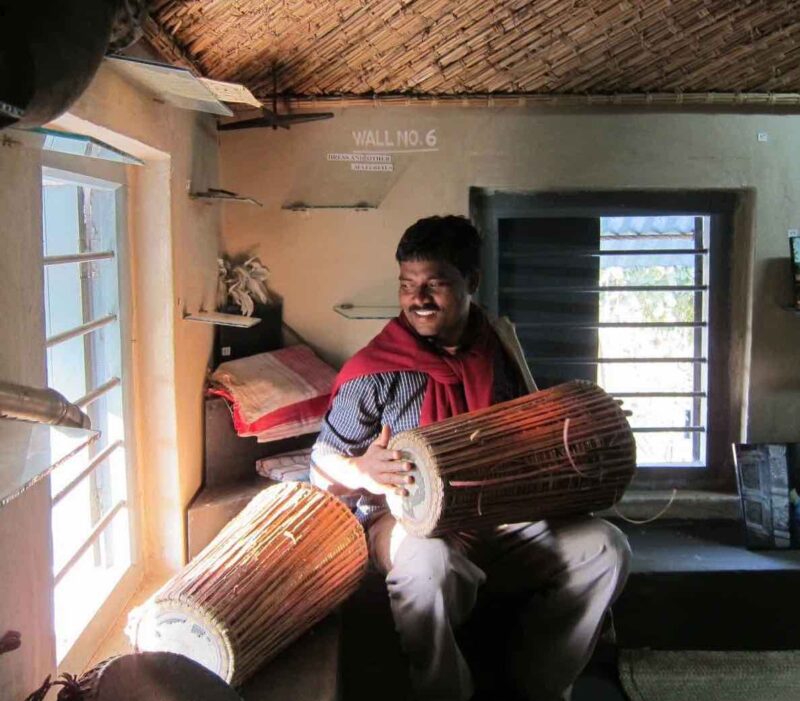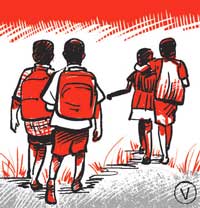By Boro Baski
The first ten years of my childhood were the golden time of my life. Those were my herding days where I used to tend the cows and goats in the fields, in the nearby jungle and by the river side with the girls and boys of my village. Those were the days, when I learnt to climb trees, swim in the rivers and catch snails and fishes and hunt birds and rabbits and feasted with my friends at the end of the village in the evening with great joy and fun. Here I learnt the various types of riddles, love songs and playing the bamboo flutes. During the herding days, I learnt how to accomplish a task as a team and developed an egalitarian mindset and overcame the gender barriers. Here I had realized the importance of love and friendship in life. The herding days was my first school, the traditional school.
One day my Mama (maternal uncle) who was a primary school teacher came and asked my mother, ‘what is babu doing nowadays?’ My mother replied, he is looking after cows and playing around the whole day.’ ‘But, he must grow up to be a human being.’ said my Mama, ‘and it is possible only through education.’ My mother said, ‘but we have no school in our village nor do we have any money to afford for his education.’ My Mama then talked to one of my distant uncle Pitu Murmu (elder brother of my father) who was then the Manjhiharam (headman) of our village. My uncle Pitu was a well off farmer and had no children. Both my uncle and aunty raised me as their own son. My uncle was convinced by my Mama’s suggestion to put me in a boarding school to make me a ‘diku’ (non- Santal) and people would respect him for his deeds.
I was sent to a Christian boarding school near Kolkata. I cried a lot because I had to leave my village friends. After six months I was brought home for a week for the summer vacation. Reuniting with my friends was like sliding back into my old life that I loved so much. But, the good days ended too quickly. But, I had decided not to return to school and hid inside a narrow pipe of an irrigation canal that went through the bush beside our village , and I hid there for an entire day. But that did not save me and I was sent back to the school and my uncle said he would never bring me back home until I completed my school final examination.
My sweet memories of the village life gradually started fading. I also gradually started to develop a liking towards my life in the boarding school. Sports like football, basketball and the other indoor games used to attract me a lot. I also started getting used to the electricity, toilet, food, cleanliness and hygiene. I no more requested my uncle to take me home as I was worried about how I would survive without electricity, fan or toilet in our house in the village. My uncle was quite happy with my development that I gradually forgot about my feelings towards my village.
Once my uncle took me home for my younger uncle’s marriage. I refused to go but he convinced me that it was important to attend the family festivals. After arriving in the village, I had sensed that a strange change had developed around me. It seemed that most of my old friends with whom I grew up did not know me, they hesitated to interact with me casually. I also did not find any common subject to discuss with them. I saw the village boys and girls merrily dancing in the marriage courtyard and I could not join them. I did learn Bengali songs with harmonium in the boarding school but never sang Santali songs nor did I dance in public. I felt ashamed of myself and stood alone observing them singing and dancing. I felt alienated among my own people.
On that very day I angrily told my mother that I would never come back to the village again. My mother, a typical Santal lady, introvert and soft spoken, did not understand my reason for such a reaction. I understood that she was sad with the emotional distance that had grown between us over the years because of my absence but did not know how to react to the situation. That was the first time I saw tears in my mother’s eyes.
A year later, a tragedy struck our family. My aunt who loved me like her son died and my uncle had become very lonely. He was often irritated and within a year he married a girl from our village who was much younger than him. And finally he decided to stop funding my education as he had his own family to look after now.
I was devastated when I had to return to the village as I could not adjust to the normal village life. However, with various ups and downs I managed to survive.
Santali language and the music are the two important life lines for the existence of the Santal tribe in the modern world, and it has helped me to reconnect with the socio-cultural life of my village and retain my Santal mentality.
I dedicate this song to some of my best friends from those herding days, Bimal Baski, who is also a co-singer in this song, Babui Murmu and Budan Mardi who sadly died at a very young age due to tuberculosis, Churki Murmu and Milani Baski who are married now and have children of their own. None of them could complete their primary education but are great musicians, singers, storytellers and overall good human beings.
I would never have become the person that I am today without their friendship and the experience of the Santal traditional way of life in the early stages of my life.
This song has got more than 1.5 million views on YouTube posted by Sundar Manoj Hembrom a few years back under the title ‘Bagi kedalang Gai Gupi Kada Gupi’. People’s response to this song inspired me to re-post it under the name ‘Gai Gupi Kada Gupi’ with English subtitles and minor changes in the video keeping the taste and emotion of the song intact.

“The goal is to prepare some model students in our villages, so that others will be inspired to follow them.” – Boro Baski in Long-term success of non-formal Adivasi school in West Bengal
Dr. Boro Baski works for the community-based organisation Ghosaldanga Adibasi Seva Sangha in West Bengal. The NGO is supported by the German NGO Freundeskreis Ghosaldanga und Bishnubati. He was the first person from his village to go to college as well as the first to earn a PhD (in social work) at Viswa-Bharati. This university was founded by Rabindranath Tagore to foster integrated rural development with respect for cultural diversity. The cooperation he inspired helps local communities to improve agriculture, economical and environmental conditions locally, besides facilitating education and health care based on modern science.
He authored Santali translations of two major works by Rabindranath Tagore, the essay “Vidyasagar-Charit” and the drama Raktakarabi (English “Red Oleanders”), jointly published by the Asiatic Society & Sahitya Akademi (India’s National Academy of Letters) in 2020.
Other posts contributed by Dr. Boro Baski >>
Ghosaldanga Bishnubati Adibasi Trust
Registration under Trust Registration Act 1982
P.O. Sattore, Dist. Birbhum
West Bengal-731 236
India
For inquiries on Santal cultural and educational programs, please contact:
Mob. 094323 57160
Residential, Ashram and Factory schools
- Ekalavya* Residential School Scheme (EMR): a network of boarding schools where tribal children are to be educated in accordance with rules and syllabi provided by the government; such schools are being designated as “Eklavya Model Residential School (EMR)” with the objective of empowering students “to be change agent, beginning in their school, in their homes, in their village and finally in a large context.” – Government Guidelines 2010 | Backup >>
- Residential School and Ashram School
In some regions there are similar “Residential Schools” and “Ashram Schools” for tribal children, as in Tripura where they are managed by a society called “Tripura Tribal Welfare Residential Educational Institutions Society (TTWREIS)” – Tribal Welfare Department, Government of Tripura - Factory schools “exist to turn tribal and indigenous children – who have their own language and culture – into compliant workers-of-the-future. The world’s largest Factory School stated that it turns ‘Tax consumers into tax payers, liabilities into assets’.” – survivalinternational.org/factoryschools | Learn more >>
Up-to-date information about these and related issues: Safe custom search engine >>
* Ekalavya (Eklavya, Eklabya): the name of a legendary archer prodigy “who, being a Nishada [Sanskrit Niṣāda, “tribal, hunter, mountaineer, degraded person, outcast”], had to give his thumb as a fee to the brahmin guru thus terminating his skill as an archer.” – Romila Thapar (“The epic of the Bharatas”) | Read the full paper here | Backup download link (pdf) >>
Note: “Forcibly transferring children of the group to another group” amounts to genocide, which the United Nations Office on Genocide Prevention defines as “acts committed with intent to destroy, in whole or in part, a national, ethnical, racial or religious group” (Article II, d & e)
Learn more about Childrens rights: UNICEF India | Ekalavya (Eklavya, Eklabya), EMR & Factory schools | Rights of Indigenous Peoples >>
Learn more
Audio | Santali Traditional and Fusion Songs: Ghosaldanga Bishnubati Adibasi Trust
eBook | Free catalogue: Banam: One of the ancient musical instruments of the Santals
eBook | Free catalogue: Museum of Santal Culture (Bishnubati) – West Bengal
Museum of Santal Culture Bishnubati
Santal | Santal Parganas | The Santals by Boro Baski | Santal music
Santal democratic organisations, customs, history and creation traditions (book tip)
Santali language | eBook | A Santali-English dictionary – Archive.org
Santal mission | Santal Parganas
Santali translations of Rabindranath Tagore’s “Vidyasagar-Charit” and “Raktakarabi”
Teaching Santal children by Boro Baski
Traditional music instruments of the Santals at the Museum of Santal Culture
Video | Roots and Branches: The Lifeworld of an Enlightened Villager in West Bengal
Video | Santali video album “Ale Ato” (Our Village, Part 1 of 2) – West Bengal
